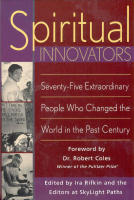| Some people find learning the disciplines of prayer difficult and trying
meditation seems more awkward than calming. Learning to still the mind
can be a stressfull experience. This meditation idea is perhaps the gentlest
introduction to meditation there is. Rather than trying to still the mind,
it says pay close attention - which is something we're very good at but
don't practice much. It says focus on this one simple thing, really really
focus. Slowly consider what your senses are telling you. It's rather like
"stopping to smell the roses". You'll find this easy, pleasant
and quite surprising. You'll appreciate a few things you had not noticied
for a while. |
 |
| The Raisin Meditation. Everyone takes a raisin and keeps it in their hand. They feel the weight
of it. With a finger they feel the texture and density of the skin and
pulp. They put it to their nose and become aware of the topography of the
scent of a raisin. And they look into the valleys and peaks, the highlights
and dark crevasses. And then they put it in their mouths, close their eyes
and take a couple of minutes to get the full experience of eating a single
raisin. They notice the trajectory of the flavor as it bursts forth, the
flood of saliva, how the flavor changes from the body's chemistry, right
into the aftertaste and the echo of the aftertaste. Many people after this
meditation say, "I didn't know there was so much in a single raisin."
"A raisin will never taste the same again." |
 |
| Take 2 or 3 raisins. If you should lose attention and swallow it, just
take another. Continue as long as the sensations register. Take another
if there is time remaining and if others are not yet done. |
 |
|
Mindfulness Meditation. A group of people sits in yoga-like positions with their eyes closed.
They are all eating raisins. Each person has some type of chronic pain,
anxiety, or stress, which has been untreatable through traditional medicine.
The man conducting this group session tells them to slowly lift one raisin
to their mouth. He asks them to observe the way their arm is lifting the
raisin, to think about how their hand is holding the raisin. He instructs
them to put the raisin in their mouth and think about how it feels there,
tells them to savor the raisin and to pay attention to their salivary glands,
their jaws, and then their teeth. He instructs them to notice their tongues
as they slowly swallow the raisin.
|
 |
| So what do raisins have to do with chronic pain? The technique teaches
people to scan their bodies, moving consciously through the painful areas
until they can relax into their discomfort. Sound crazy? Experts believe
that by changing your body language and physical posture you can change
your attitude and feelings, including your attitude toward suffering. Most
of us live with our minds on "autopilot." The people in the raisin
group were practicing an "eating meditation," mindful of the
raisin, living in the moment, becoming aware of something other than their
pain. One of the men in the group said that by the time he got to his third
raisin, the pain seemed to lessen. |
 |
 |


